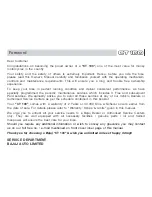
Here are some situations:
•
A driver
in the lane next to you is driving too closely to the vehicle ahead and may want to pass.
•
A parked car
has someone in the driver’s seat.
•
Someone is in the street
, riding a bicycle or walking.
In an emergency, press the horn button loud and long. Be ready to stop or swerve away from the danger.
Keep in mind that a motorcycle’s horn isn’t as loud as a car’s — therefore, use it, but don’t rely on it. Other strategies may be appropriate along with the horn.
RIDING AT NIGHT
At night it is harder for you to see and be seen. Picking your headlight or taillight out of the car lights around you is not easy for other drivers.
To compensate, you should:
•
Reduce Your Speed
— Ride even slower than you would during the day — particularly on roads you don’t know well. This will
increase your chances of avoiding a hazard.
•
Increase Distance
— Distances are harder to judge at night than during the day. Your eyes rely upon shadows and light contrasts to
determine how far away an object is and how fast it is coming. These contrasts are missing or distorted under artificial lights at night.
Open up a three-second following distance or more. And allow more distance to pass and be passed.
•
Use the Car Ahead
—The headlights of the car ahead can give you a better view of the road than even your high beam can. Taillights
bouncing up and down can alert you to bumps or rough pavement.
•
Use Your High Beam
— Get all the light you can. Use your high beam whenever you are not following or meeting a car. Be visible:
Wear reflective materials when riding at night.
•
Be Flexible About Lane Position.
Change to whatever portion of the lane is best able to help you see, be seen and keep an adequate
space cushion.
CRASH AVOIDANCE
No matter how careful you are, there will be times when you find yourself in a tight spot. Your
chances of getting out safely depend on your ability to react quickly and properly. Often, a
crash occurs because a rider is not prepared or skilled in crash-avoidance maneuvers.
Know when and how to stop or swerve, two skills critical to avoiding a crash. It is not
always desirable or possible to stop quickly to avoid an obstacle. Riders must also be
able to swerve around an obstacle. Determining the skill necessary for the situation is
important as well.
Studies show that most crash-involved riders:
•
Underbrake
the front tire and overbrake the rear.
•
Did not
separate braking from swerving or did not choose swerving when it was
appropriate.
The following information offers some good advice.
QUICK STOPS
To stop quickly, apply both brakes at the same time. Don’t be shy about using the front brake,
but don’t “grab” it, either. Squeeze the brake lever firmly and progressively. If the front wheel
locks, release the front brake immediately, then reapply it firmly. At the same time, press down
on the rear brake. If you accidentally lock the rear brake on a good traction surface, keep it
locked until you have completely stopped. Even with a locked rear wheel, you can control the
motorcycle on a straightaway
if it is upright and going in a straight line.
Always use both brakes at the same time to stop. The front brake can provide 70% or more of
the potential stopping power. If you must stop quickly
while turning or riding a curve
, the best
technique is to straighten the bike upright first and then brake. However, it may not always be pos-
sible to straighten the motorcycle and then stop. If you must brake
while leaning, apply light brakes and reduce the throttle. As you
slow, you can reduce your lean angle and apply more brake pres-
sure until the motorcycle is straight and maximum brake pressure
is possible. You should “straighten” the handlebars in the last few
feet of stopping. The motorcycle should then be straight up and in
balance.
SWERVING OR TURNING QUICKLY
Sometimes you may not have enough room to stop, even if you
use both brakes properly. An object might appear suddenly in
your path. Or the car ahead might squeal to a stop. The only way
to avoid a crash may be to turn quickly, or swerve around it.
17
BRAKE, THEN SWERVE
SWERVE, THEN BRAKE
7
Test Yourself
Reflective clothing should:
A. Be worn at night.
B. Be worn during the day.
C. Not be worn.
D. Be worn day and night.
Answer - page 25
STOPPING DISTANCE
Summary of Contents for HSMV 71905
Page 26: ...26...











































